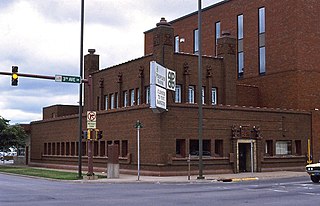
The Peoples Savings Bank in Cedar Rapids, Iowa, was designed by Louis Sullivan. It was the second of a number of small "jewel box" banks in midwest towns designed by Sullivan during 1907 to 1919. It was built in 1911, and it was individually listed on the National Register of Historic Places in 1978. In 2014 it was included as a contributing property in the West Side Third Avenue SW Commercial Historic District.

The Merchants' National Bank (1914) building is a historic commercial building located in Grinnell, Iowa. It is one of a series of small banks designed by Louis Sullivan in the Midwest between 1909 and 1919. All of the banks are built of brick and for this structure he employed various shades of brick, ranging in color from blue-black to golden brown, giving it an overall reddish brown appearance. It was declared a National Historic Landmark in 1976 for its architecture. In 1991 it was listed as a contributing property in the Grinnell Historic Commercial District.

The People's Federal Savings and Loan Association is a historic bank building at 101 East Court Street in Sidney, Ohio, designed by Chicago architect Louis Sullivan. It was designed and built in 1917 for use by Peoples Federal Savings and Loan Association, which still operates out of it. It is one of a handful of banks designed by Sullivan between 1908 and 1919 for small communities in the central United States. The building is a National Historic Landmark.
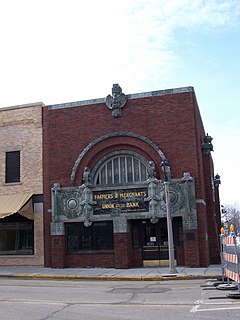
The Farmers and Merchants Union Bank is a historic commercial building at 159 West James Street in Columbus, Wisconsin, Built in 1919, it is the last of eight "jewel box" bank buildings designed by Louis Sullivan, and the next to last to be constructed. It was declared a National Historic Landmark in 1976 for its architecture.

Davenport Bank and Trust Company was for much of the 20th century the leading bank of the Quad Cities metropolitan area and the surrounding region of eastern Iowa and western Illinois. It was at one time Iowa's largest commercial bank, and the headquarters building has dominated the city's skyline since it was constructed in 1927 at the corner of Third and Main Streets in downtown Davenport, Iowa. It was acquired by Norwest Bank of Minneapolis in 1993 and now operates as part of Wells Fargo following a 1998 merger of the two financial institutions. The historic building was listed on the National Register of Historic Places in 1983 under the name of its predecessor financial institution American Commercial and Savings Bank. In 2016 the National Register approved a boundary increase with the Davenport Bank and Trust name. It was included as a contributing property in the Davenport Downtown Commercial Historic District in 2020. It remains the tallest building in the Quad Cities, and is today known as Davenport Bank Apartments as it has been redeveloped into a mixed-use facility housing commercial, office and residential space.

The Davenport Hotel is a historic building located in downtown Davenport, Iowa, United States. It was individually listed on the National Register of Historic Places in 1983. In 2020 it was included as a contributing property in the Davenport Downtown Commercial Historic District. It is currently an apartment building called The Davenport.

The E.P. Adler House is a historic building located in the central part of Davenport, Iowa, United States. It has been individually listed on the National Register of Historic Places since 1983. In 1984 it was included as a contributing property in the Vander Veer Park Historic District. It has been on the Davenport Register of Historic Properties since 2008.
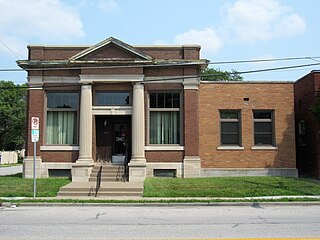
Northwest Davenport Savings Bank is a historic building located in a commercial district in the old northwest section of Davenport, Iowa, United States. It has been listed on the National Register of Historic Places since 1984.

The Union Arcade is an apartment building located in downtown Davenport, Iowa, United States. The building was individually listed on the National Register of Historic Places in 1983 by its original name Union Savings Bank and Trust. Originally, the building was built to house a bank and other professional offices. Although it was not the city's largest bank, and it was not in existence all that long, the building is still associated with Davenport's financial prosperity between 1900 and 1930. From 2014 to 2015 the building was renovated into apartments and it is now known as Union Arcade Apartments. In 2020 it was included as a contributing property in the Davenport Downtown Commercial Historic District.

Downtown Durham Historic District is a national historic district located at Durham, Durham County, North Carolina. The district encompasses 97 contributing buildings and 1 contributing structure in the central business district of Durham. The buildings primarily date from the first four decades of the 20th century and include notable examples of Colonial Revival, Italianate, and Art Deco architecture. Notable buildings include the St. Philip's Episcopal Church (1907), Trinity Methodist Episcopal Church (1880-1881), First Baptist Church (1926-1927), Durham County Courthouse (1916), Durham Auditorium, Tempest Building, National Guard Armory (1934-1937), United States Post Office (1934), Trust Building (1904), First National Bank Building (1913-1915), Mechanics and Farmers Bank (1921), Johnson Motor Company showroom (1927), Hill Building (1935), Snow Building (1933), and S. H. Kress store.

Farmers and Merchants Savings Bank, also known as Union Savings Bank and First Trust and Savings Bank, is an historic building located in Grand Mound, Iowa, United States. It was listed on the National Register of Historic Places in 2001.
CBI Bank & Trust, formerly known as Central State Bank, is a community banking organization based in Muscatine, Iowa. It is a subsidiary of Central Bancshares, Inc., a bank holding company that is also based in Muscatine. Total assets are over $1.1 billion and it employs approximately 230 individuals. The bank traces its origins to 1865 and serves over 43,000 households and businesses with a full range of banking and financial services delivered through 16 banking centers in Coralville, Davenport, Kalona, Muscatine, Walcott, Washington and Wilton, Iowa and Brimfield, Buffalo Prairie, Galesburg and Peoria, Illinois, as well as through a variety of electronic banking channels.

The State Bank of Stratford is a historic building located in Stratford, Iowa, United States. The bank opened for business in 1891, eight years after the town was incorporated. Its early success reflected the prosperity in rural Iowa at the time. The bank occupied this corner since 1910, and this building was completed in 1918. The older building was relocated to the west, and it is still extant. It survived the agricultural economic downturn of the 1920s, but it could not survive the Great Depression. The bank building was purchased in 1936 by the Farmer's Savings Bank, which operated in this building until a new bank building was built across the street to the south. The Georgian Revival elements of the building include the pedimented entrance portico, elliptical arched windows, the brick quoining on the corners, and the dentilated cornice. The building was listed on the National Register of Historic Places in 1983.

Bozeman-Waters National Bank, also known as the Farmers Bank & Trust Company, is a historic bank building located at Poseyville, Posey County, Indiana. It was built in 1924, and is a 1+1⁄2-story, brown brick building with Sullivanesque terra cotta ornamentation. It has a one-story rear section. The interior was extensively remodeled in 1957. The building is modeled on the People's Federal Savings and Loan Association in Sidney, Ohio.
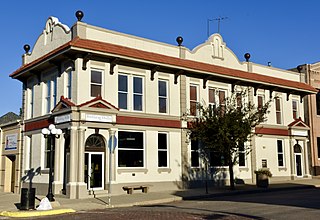
German Bank Building of Walnut, Iowa, also known as the Walnut State Bank Building, is a historic building located in Walnut, Iowa, United States. A two-story, brick building was completed on this corner in 1884. It housed a blacksmith shop and a land and loan business by 1887. The German Savings bank was organized in 1893, and used this building for a short time before it folded the following year. It was reorganized and re-opened in 1898. They renovated the building to its present exterior in the Mission Revival style in 1916, and the interior in 1920. The interior renovation was done by the St. Louis Bank Equipment Company. The Walnut Telephone Company began as a tenant on the second floor in 1919. While German immigrants remained in control, the bank's name was changed to American State Bank in 1920 because of anti-German sentiment following World War I. It was reorganized in 1923 as the Walnut State Bank. It was listed on the National Register of Historic Places in 1991.

State Savings Bank, also known as the Old Savings Bank, is a historic building located in Council Bluffs, Iowa, United States. the bank was established in 1889, and was originally located across the street. Planning for this building began in 1941 with the organization of the State Investment Company, which would build and own the building. It was designed by W.G. Knoebel and built by St. Louis-based Bank Building and Equipment Corporation of America. It is a late example of Art Deco, and it's the only building in Council Bluffs that exhibits this style. Two-thirds of the building is a single-story banking facility, and the rest is divided into two-stories of office space. It has one of the first drive-through teller windows in Iowa. The rectangular building's exterior is finished in gray limestone on two elevations, and a wrap-around continuation on a third. Its primary decorative feature is an inscribed harvest motif on the east and west elevations that are mirror images of each other, oriented to the north. The motif features a male nude holding a wagon wheel and a scythe, with sheaves of wheat and a dog.

The John Bell Block, also known as the German Bank & Trust Building, is a historic building located in Dubuque, Iowa, United States. The three-story brick commercial Italianate building was constructed by local businessman John Bell in 1886. Its location on the north side of the central business district meant that it housed several businesses owned by the city's German immigrant population. Chief among them was the German Trust and Savings Bank. It became a tenant when the building was completed and it remained until it built its own building in 1922. In 1918 anti-German sentiments that resulted from World War I forced the bank to change its name to Union Trust and Savings Bank. It remained in operation until 1932 when a run on its deposits as a result of the Great Depression forced it to fail. Its building was taken over by Dubuque Bank and Trust. Three prominent Dubuque professionals also had offices on the second floor of the building. German-born architect Martin Heer had offices beginning in 1888. He partnered with another German-born architect, Guido Beck, from 1889 to 1895. Beck was noted for his commercial blocks and churches. Contractor Anton Zwack had offices here from 1911 to c. 1965. The building was listed on the National Register of Historic Places in 2002.

The Bicksler Block is a historic building located in Salem, Iowa, United States. John Bicksler had this commercial building built in 1886. The two story, brick structure is a combination of the Romanesque Revival and the Italianate styles. Salem's central business district was plagued by fires from 1886 to 1933. This building was built after the first major fire to effect the town in 1886. The store front on the east side of the building housed a bank into the early 1900s and then the local post office was located here until 1967. The western half of the building has housed a variety of businesses over the years, including: clothing stores, two different milliners, a restaurant, and a pool hall. The second floor housed a variety of offices, including a dentist. The American Legion acquired the building from the Bicksler family in 1950. It was listed on the National Register of Historic Places in 2010.

Parish Apartments, also known as the Sigma Pi Fraternity House and the St. Thomas More Parish Center, is a historic building located in Iowa City, Iowa, United States. Located in the Manville Heights neighborhood, it was built as a fraternity house for Sigma Pi in the 1929. The design for the three-story stone Tudor Revival structure is attributed to Madison, Wisconsin architect Myron Edwards Pugh. It was built at the height of fraternity house construction at the University of Iowa. The Xi Psi Phi fraternity joined Sigma Pi in the house in 1936, and Psi Omega joined two years later. The residency of these other fraternities was most likely due to a decline in enrollment during the Great Depression. It was not enough, however, as First Trust and Savings Bank of Davenport acquired the building at a sheriff's sale in 1943.
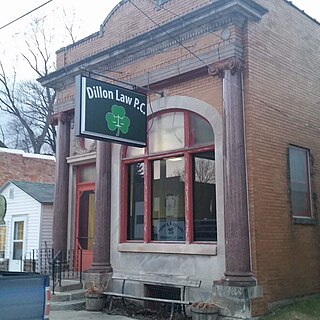
Farmers' State Bank is a historic building located in Volga, Iowa, United States. Its significance is derived from its Beaux-Arts architecture and the bank's role in the town's early 20th-century agriculture-based economy and railroad development along a branch of the Chicago, Milwaukee & St. Paul Railroad. Completed in 1912, the Beaux Arts elements on the buildings main façade includes a large elliptical-arch window, Ionic granite columns, classical entablature, and circle window above the door framed by garlands. Farmers' State Bank was Volga's second financial institution. It survived the downturn in the farm economy in the 1920s before it merged with the other bank in town in 1931 to form Iowa State Savings Bank. That bank used this building until the following year when it failed. The city of Volga acquired the building in 1935 and used it for its public library and city hall. It was used for a bank again from 1947 to 2015 when it housed Volga State Bank and the Volga branch of Central State Bank of Elkader. The building then housed a law office. It was listed on the National Register of Historic Places in 2018.






















